-
CENTRES
Progammes & Centres
Location
 PDF Download
PDF Download 
Sohini Bose, Anasua Basu Ray Chaudhury and Harsh V. Pant, “BIMSTEC on the Cusp: Regional Security in Focus,” ORF Issue Brief No. 563, July 2022, Observer Research Foundation.
Introduction
Littorals of the Bay of Bengal face a myriad of security concerns, including those caused by the aggression of certain states, illicit activities, and environmental degradation. In recent years, China’s expanding presence in the Bay has roused apprehensions amongst the member countries of BIMSTEC (Bay of Bengal Initiative for Multi-Sectoral Technical and Economic Cooperation)[a] about preserving the autonomy of the shipping routes that are important for trade in resources such as energy. In a future that will likely be characterised by worsening energy scarcity, the hydrocarbon-rich Bay of Bengal will only become more pivotal to international relations.[1]
The growing interest of external players such as the United States (US) and China has propelled the Bay to the centre-stage of strategic power play and resource politics in the region. The Bay—whose natural turbulence makes it vulnerable to disasters—is facing aggravated security threats including terrorism and transnational crime. The littoral countries are therefore keen to rejuvenate BIMSTEC and strengthen cooperation in order to deal more effectively with these challenges and promote stability in the region.
Despite constituting close to 22 percent (nearly 1.5 billion people) of the world’s population and its member states having a combined gross domestic product (GDP) of US$ 2.7 trillion,[2] BIMSTEC has largely been dormant. The increased strategic attention on the Bay of Bengal has rejuvenated BIMSTEC, prompting it to undertake certain structural changes. In its fifth Summit meeting on 30 March 2022, it reorganised its sectors of cooperation and grouped the 14 sectors into seven broad areas of concern: trade, investment, and development (led by Bangladesh); environment and climate change (Bhutan); security[b] (India); agriculture and food security (Myanmar); people-to-people contact (Nepal); science, technology, and innovation (Sri Lanka); and connectivity (Thailand).[3]
The aim of this brief is threefold: to evaluate how BIMSTEC’s own mandate of ‘Security’ corresponds with the security scenario in the Bay; to assess its contributions in the security sub-sectors of counterterrorism and transnational crime, disaster management, and energy; and to identify ways in which it can strengthen regional security more effectively.
Security in the Bay and the BIMSTEC Mandate
The Bay of Bengal is strategically located at the confluence of the Indian and Pacific Oceans. Challenges abound in this maritime space, as do opportunities, given its important Sea Lanes of Communication (SLOCs) and hydrocarbon reserves. The following paragraphs discuss the traditional and non-traditional security challenges facing the littorals of the Bay.
The primary traditional security concern[c] in the Bay is protecting freedom of navigation along the SLOCs that are critical for trade in energy and other resources. Many of these routes are straddled by the Andaman and Nicobar Islands (ANI) chain.[d] One of the world’s busiest shipping lanes, the East-West shipping route[e] passes along just 8 nautical miles below the southern tip of this archipelago before flowing into the Strait of Malacca. The protection of these trade routes is important for the Bay littoral countries and the other regional stakeholders. As China asserts it presence in the region to deal with its so-called ‘Malacca Dilemma’,[f] India is strengthening its naval presence in the ANI and has undertaken joint naval exercises such as Milan,[4] as well as coordinated patrols with countries like Thailand[5] and Indonesia.[6]
The NTS concerns[g] in the Bay of Bengal region can be classified into three broad categories, to be discussed in turn in the following paragraphs.
a. Terrorism and Transnational Crime
Terrorism
All the BIMSTEC member countries are vulnerable to terrorism, either as victims of terror attacks or as “breeding grounds” for terrorists. Most terror networks engage in money laundering and drug trade to finance their activities.[7] The Global Terrorism Index 2022 ranks the BIMSTEC member countries as follows: Myanmar holds the 9th rank, closely followed by India (12th), Thailand (22nd), Sri Lanka (25th), Nepal (34th), Bangladesh (40th), and Bhutan (93rd).[8] Other countries such as Pakistan, Afghanistan, and Indonesia, which rank high on the index, share borders or maritime boundaries with certain BIMSTEC states.[9]
Piracy
As regards transnational crime, the illegal activities that are most prevalent in the Bay region include trade of narcotic substances, sea piracy, illegal fishing, undocumented migration, and human trafficking. Instances of piracy, armed robbery (see Figure 1),[10] and kidnapping of fishermen for ransom, have been reported in some areas such as the Chittagong anchorages of Bangladesh, and the Sundarban mangroves. Widespread poverty, population density, and lack of livelihood opportunities due to overfishing allow such illegal activities to thrive.
Figure 1: Sea Piracy in BIMSTEC Countries (2010-2018)
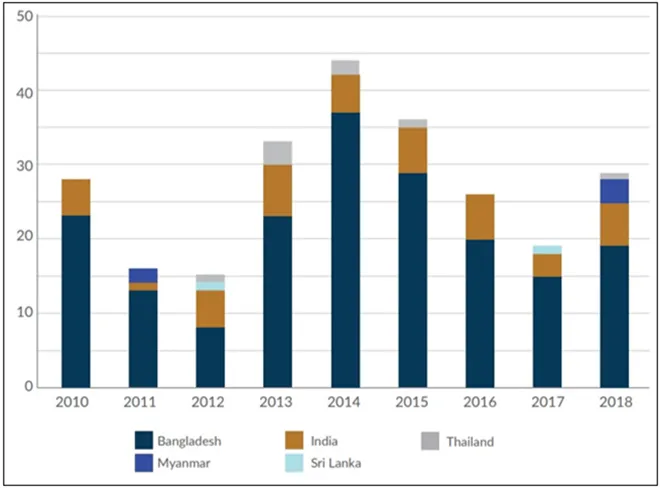
Illegal, unreported and unregulated (IUU) fishing
As the practise of overfishing depletes fish stocks, fishermen and fishing trawlers are increasingly transgressing maritime boundaries and entering foreign waters in search of bigger catch. This is particularly easy in the Bay as almost 80 percent of it is a contiguous belt of Exclusive Economic Zones belonging to the various littoral countries. Frequent illegal forays into foreign waters act as irritants in bilateral relations, as they compromise the affected country’s food and economic security. Violence can lead to loss of fishermen’s lives, as was seen between India and Sri Lanka during the latter’s civil war years (1991-2009).[12] To be sure, illegal fishing may not always be intentional—many fishermen end up in foreign waters due to lack of awareness about boundaries.[13] “For 17 countries of South Asia and Southeast Asia, the total annual value of illegal and unreported losses between 1990 and 2013 was found to be between US$6 billion and US$20.75 billion. These values represented between 4.5 and 14.4 million tonnes of marine catch.”[14]
Illegal migration
The problem of illegal migration has also surfaced in the Bay in recent years, as the Rohingya Muslims flee Myanmar to escape persecution. While some crossed the border to Bangladesh, others undertook journeys across the Bay, in the worst cases falling victim to deadly diseases.[15]
Human trafficking
Authorities agree that the routes, methods, and activities of human traffickers have become increasingly organised. Criminal syndicates have a greater degree of penetration, both within and outside the region.[16] However, statistics are limited and being contested, making it difficult to create an accurate account of the current situation.
b. Natural disasters
As the Bay of Bengal lies in the “World Hazard Belt” that is the Indian Ocean, it confronts environment-related security concerns.[h] Due to their sheer geography, many BIMSTEC countries experience varying degrees of vulnerability to natural disasters such as cyclones, tsunamis, landslides and earthquakes, where millions lose their lives or are displaced (see Figure 2). The geophysical formation of the Bay[i] is the primary reason why it is prone to cyclones. It also experiences frequent tsunamis as the Andaman and Sumatra Subduction Zone —a high-risk seismic zone—is in close proximity.[17]
Figure 2: Impact of the 2004 Tsunami and Recent Cyclones on BIMSTEC countries
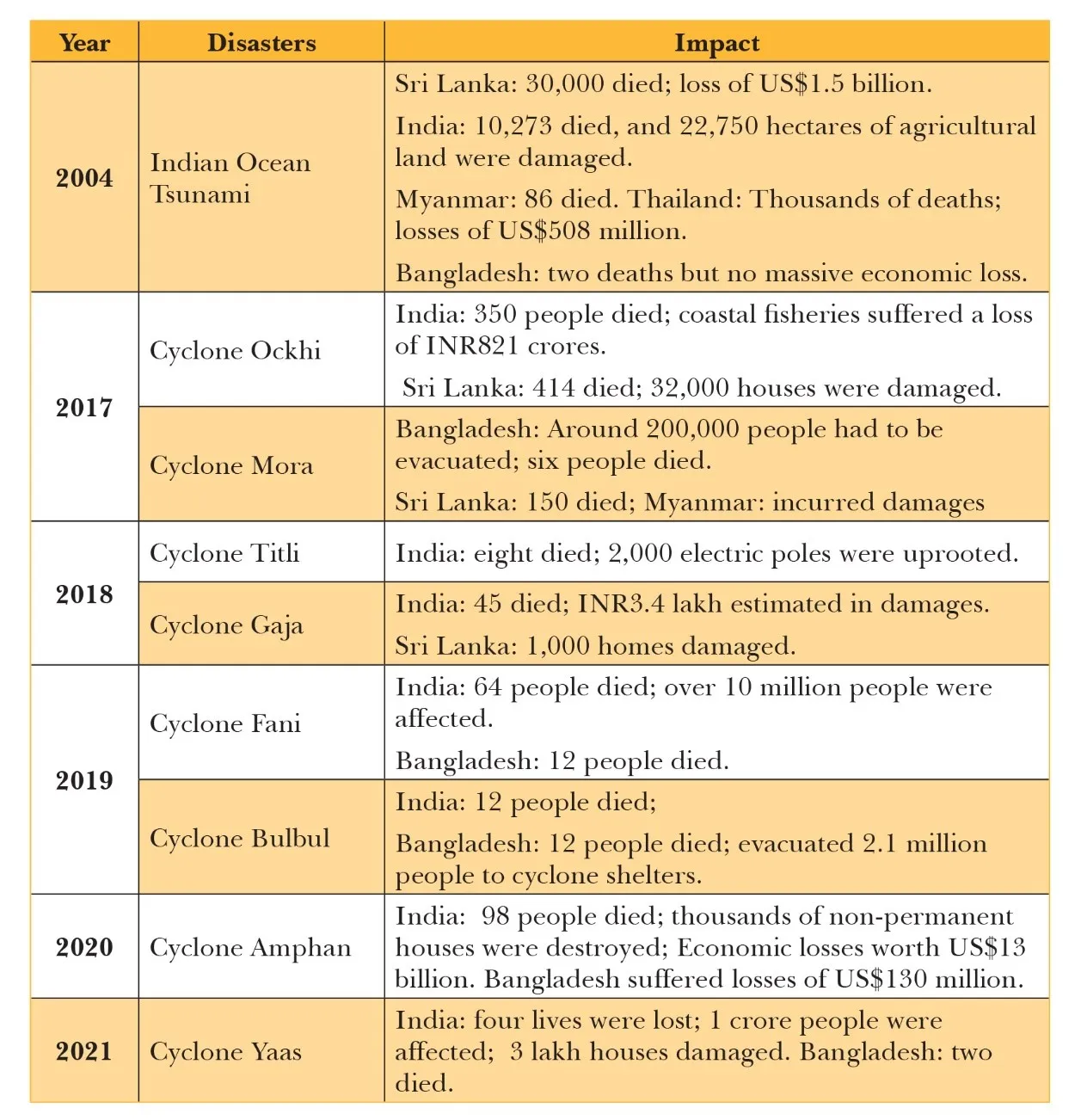
c. Energy scarcity
Various factors contribute to the rise in primary energy[j] consumption per capita in BIMSTEC countries—among them are rapid economic growth, industrialisation, and increasing demand for goods and services. According to BIMSTEC Energy Outlook 2030,[18] the total primary energy supply in the BIMSTEC region in 2008 was 772 million tonnes of oil equivalent (Mtoe), which is estimated to increase to 1,758 Mtoe by 2030. Meanwhile, the total primary energy consumption was 539 Mtoe in 2008 and is projected to increase to 1,210 Mtoe by 2030. Though the share of oil in total primary energy consumption is expected to decline from 33 percent in 2008 to 29 percent by 2030, coal remains the primary source of energy.[19]
Most of the BIMSTEC countries are dependent on imports to meet their primary energy needs. As Figure 3 shows, the supply-demand gap for electricity in BIMSTEC is expected to increase more than three times by 2030, whereas the supply-demand gap for oil resources is expected to improve in 2030. Figure 4 shows that net imports of energy by the region have increased by almost 2.5 times between 2005 and 2018; self-sufficiency has declined from 80 percent in 2005 to 72 percent in 2018.[k]
Figure 3: BIMSTEC Primary Energy Supply-Demand Gap
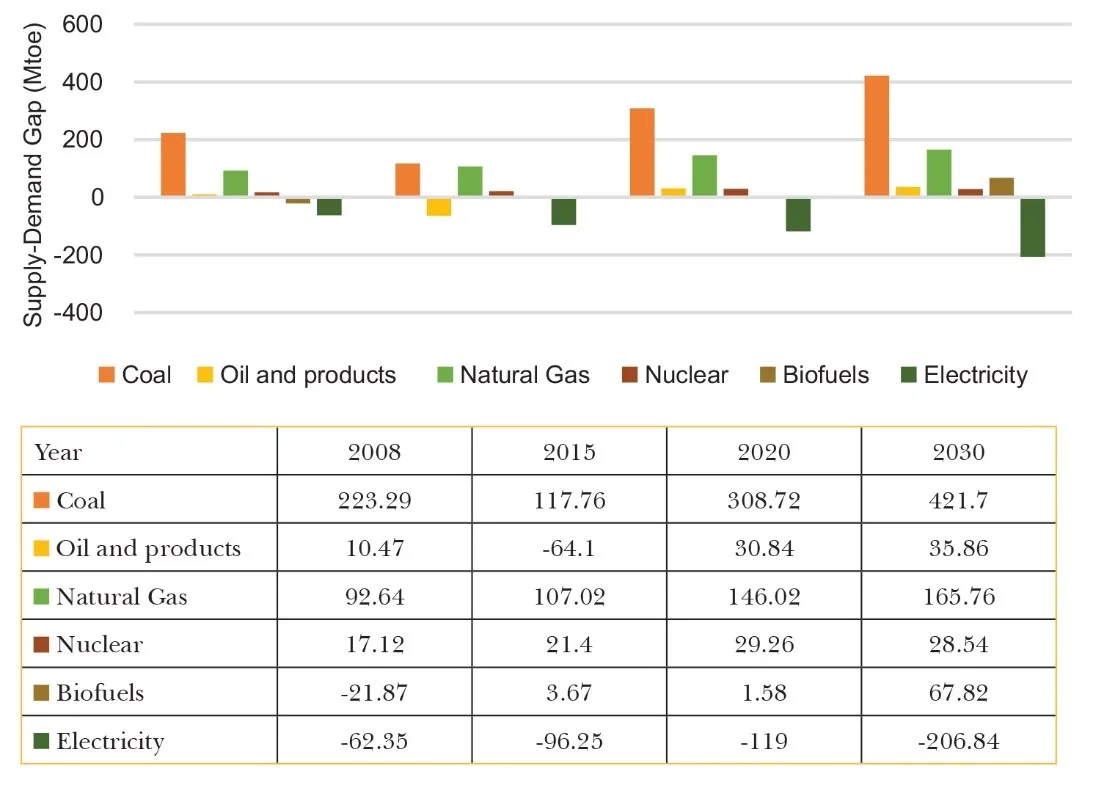
Figure 4: BIMSTEC Energy Imports and Self-Sufficiency
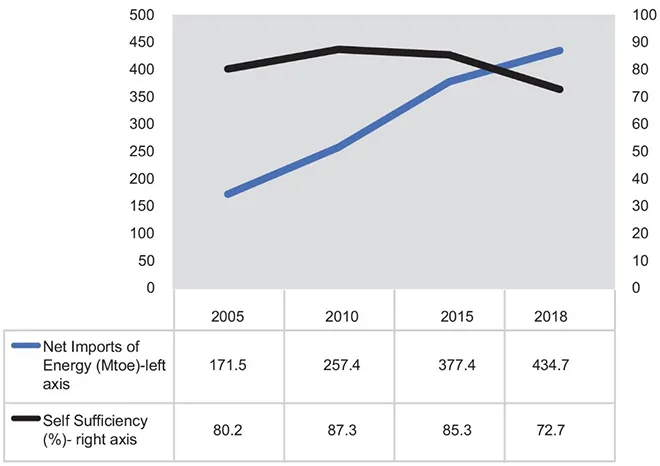
The per capita electricity consumption in the region remains low, though significant improvements in ensuring access to electricity have been made in recent years. Except for Bhutan, all the other BIMSTEC countries’ per capita electricity consumption is below the world average[22] of 3,501 kWh/capita in 2019.
Though electricity consumption will increase in the near future, the supply will remain inadequate. Increasing cross-border trade in electricity will therefore be an important component for ensuring energy security[l] in the region.
One of the foundational principles of BIMSTEC is “non-interference in internal affairs.”[23] This stance has been re-endorsed by the BIMSTEC Charter, which does not provide any conflict resolution mechanism but rather leaves it to the member states to settle disputes.[24] It may be argued that in today’s changing security scenario, this restraint from engaging in efforts to ensure the autonomy of SLOCs is a gap in the organisation’s agenda. This nature stems from the fact that most member states are dependent on China for trade and investments, and would not be willing to get involved in overtly political-military activities that could offend Beijing.
Realising how a stable region contributes to economic prosperity, the BIMSTEC member states decided to collaborate in mitigating purely non-traditional security threats. Consequently, the BIMSTEC Charter embodies one of the key aims: “To maintain peace and stability in the Bay of Bengal region through close collaboration in combating international terrorism, transnational organised crimes as well as natural disasters, climate change, and communicable diseases.”[25] The organisation’s mandate is therefore purely non-traditional security.
The Guardian of the Bay
BIMSTEC’s recent addition of the ‘Security’ sector, combining its previous sectors of ‘Counter Terrorism and Transnational Crime’ (CTTC), ‘Environment and Disaster Management’, and ‘Energy’, for the sake of better functionality was a prudent change. The sector falls under the leadership of India. The following paragraphs describe the progress so far in each of these erstwhile independent sectors.
For the BIMSTEC leaders, the fight against terrorism and organised crime is key to ensuring peace and sustainable growth in the region. They are coordinating efforts through exchange of information and other concrete programmes[26] such as the creation of the sector on ‘Counter Terrorism and Transnational Crime’ in 2005, and the BIMSTEC Convention on Combating International Terrorism, Transnational Organized Crime and Illicit Drug Trafficking, in 2008. Under this convention, BIMSTEC vowed to combat international terrorism, transnational organised crime, and trafficking in narcotic drugs and psychotropic substances including their precursor chemicals, through cooperation between their law enforcement agencies, notification of nodal authorities, and a review of implementation of this Convention. However, the period for undertaking this review remained unspecified.
Moreover, although information sharing was the primary means of cooperation, a clause was inserted for “Refusal of Request.”[m],[27] For long, the treaty had only been ratified by India and Bangladesh[28] and came into force as recently as on 16 March 2021. Other conventions such as the BIMSTEC Convention on Mutual Legal Assistance in Criminal Matters of 2014, too, came into force after a protracted period. The BIMSTEC Convention Against Trafficking in Persons, BIMSTEC Convention on Transfer of Sentenced Persons, and BIMSTEC Convention on Extradition are still being negotiated.[29]
Many important agencies that could best tackle the emerging threats of the 21st century are yet to be established, such as a BIMSTEC nodal agency for coordinating activities in counterterrorism[30] and a primary agency for cyber terrorism.
Figure 5: Sub-Groups Under the BIMSTEC CTTC Sub-Sector
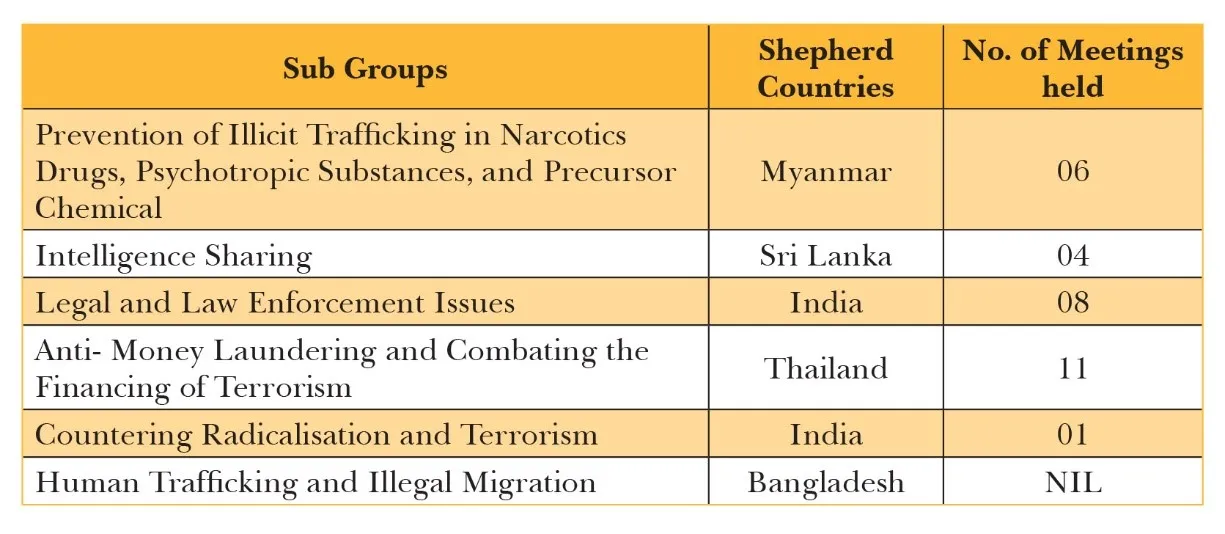
It was not until the devastating Indian Ocean tsunami of 2004 that BIMSTEC recognised the need for formulating a regional mechanism for disaster management. Within a year, a new area of cooperation, ‘Environment and Disaster Management’, was added to BIMSTEC’s portfolio, with India as the lead. As the memory of the tsunami faded, though, disaster management went into a state of stupor, which would eventually be broken by a series of events.[32]
The new government in India that came in 2015, under Prime Minister Narendra Modi, prioritised security cooperation with its eastern neighbourhood under its ‘Act East’ policy. Accordingly, BIMSTEC emerged as a natural platform[33] for promoting ‘disaster diplomacy’. The failed Summit of the SAARC (South Asian Association for Regional Cooperation) in 2016 gave further impetus to this sector and the BIMSTEC grouping, as it convinced the member states to re-engage with one another for a more collaborative future.[34] A number of developments were witnessed in disaster management under BIMSTEC (see Figure 6).
Figure 6: Recent Developments in Disaster Management under BIMSTEC
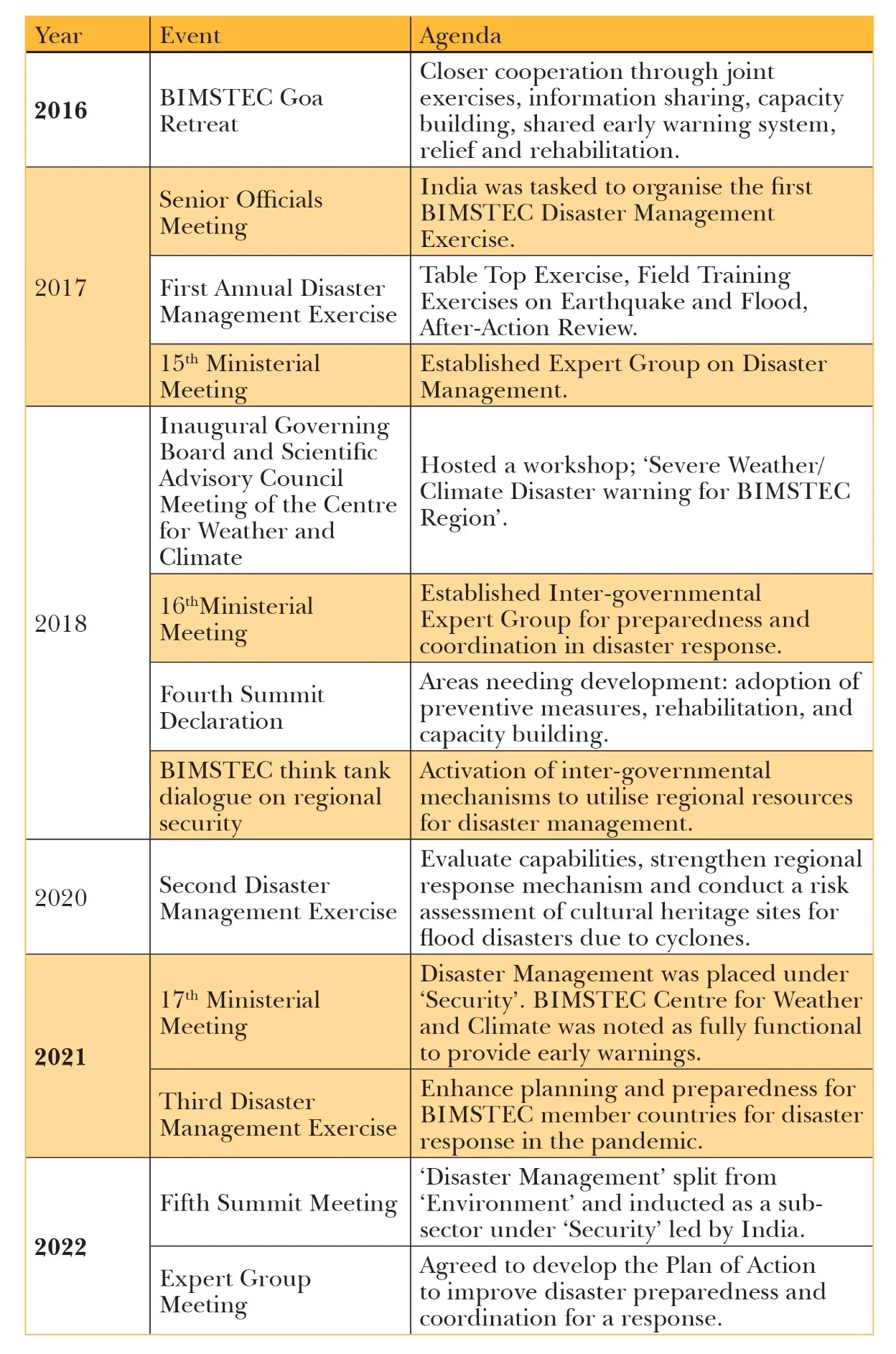
Although the sector is named ‘Environment and Disaster Management,’ work had only been done on the latter. BIMSTEC is focusing more on enhancing disaster preparedness in the region despite multiple obstacles to hosting its joint disaster management exercises. Nonetheless, with ‘Disaster Management’ now joining the cohort of security concerns under BIMSTEC, its security orientation will be more emphasised and will highlight the need for urgent measures to manage it involving the armed forces. The stress will be on disaster preparedness and response, justifying its separation from ‘Environment’ which requires collaboration in different dimensions with a more long-term approach.
The first BIMSTEC Ministerial Conference[35] on Energy was held in New Delhi in 2005, where the ‘Plan of Action for Energy Cooperation in BIMSTEC’ was formulated; BIMSTEC Grid Interconnection Master Plan Study (BGIMPS) after the BIMSTEC Energy Ministerial Meeting (BEMM) in Thailand in 2010 was set up; the adoption of the 2011 Memorandum of Association (MoA) for the establishment of the BIMSTEC Energy Centre in Bengaluru, India and the signing of an MoU on BIMSTEC Grid Interconnection by the member countries in 2018. BIMSTEC Grid Interconnection[36] aims to expand energy trade amongst member states and accelerate the development of new hydropower projects, interconnection of electricity and natural gas grids, implementation of viable renewable energy projects, and sharing of experiences, knowledge, and information on energy efficiency programmes.
A cross-border electricity network will ensure a quality supply of power at a lower cost and enhance energy efficiency. India’s national policy on Cross Border Electricity Trade (CBET) also assumes importance in this initiative due to its geographic centrality in the region. While India’s CBET guidelines have incentivised electricity trade in the region, some key elements are yet to be developed. These include establishing a supranational authority to harmonise policies, regulations, and legislations.
Focus areas for the future
In recent years, India has been nurturing the idea of ‘Security and Growth for All in the Region,’ or SAGAR; to further enhance it, the Indo-Pacific Ocean’s Initiative was announced, with seven pillars to support the building of a rules-based regional architecture. Amongst these, three pillars—maritime security, maritime resources, and disaster risk reduction, resonate well with its role in BIMSTEC as the lead for Security. There is thus a convergence between India’s strategic aspirations and the organisation’s priorities. Already the lead country for the CTTC and Disaster Management within BIMSTEC, India is poised to holistically address the issue of non-traditional security in the Bay with the ‘Energy’ sub-sector being added to its responsibilities under the umbrella of ‘Security’.
Keeping the facet of freedom of navigation in mind, the BIMSTEC National Security Chiefs have planned future initiatives “to deal with traditional and non-traditional security threats” in the Bay (see Figure 7).
Figure 7: BIMSTEC’s Security Plans
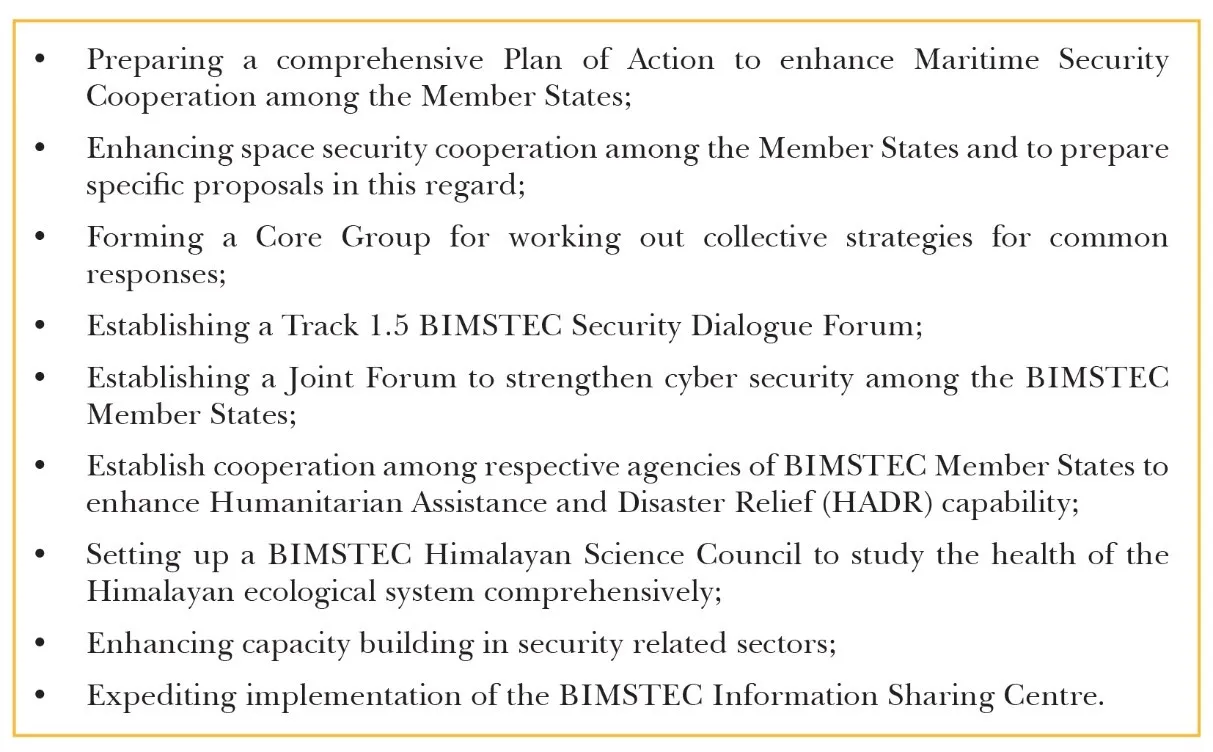
There are other issues that BIMSTEC must look into, for the sector on ‘Security’ to become truly meaningful. The following points outline recommendations.
Conclusion
BIMSTEC’s primary imperative is to streamline its security sub-sectors; it also needs institutional reforms. It can play a meaningful role only if its initiatives have strong structural, legal, and financial backing. The BISMTEC Charter has provided it the much-needed structural and legal clarity by laying down the institutional and decision-making system of BIMSTEC and extending the legal identity of an ‘inter-governmental organisation’.
In financial terms, however, the Charter makes no mention of establishing the BIMSTEC Developmental Fund with voluntary contributions from member states—a possibility that the Fourth BIMSTEC Summit Meeting had considered worth exploring for planning and financing of projects.[38] Without a steady flow of funds, BIMSTEC will not be able to develop its areas of cooperation and strengthen security in the Bay.
The true test of these changes is in whether BIMSTEC can better respond to on-ground situations where the grouping has often been found wanting. This was recently witnessed in BIMSTEC’s response to the COVID-19 pandemic. Its passive response considerably dented its credibility, especially as other regional organisations such as SAARC and ASEAN had undertaken specific initiatives in the wake of the health crisis. The only response came as late as December 2021, when BIMSTEC, through its third disaster management exercise, PANEX-21,[n] sought to improve regional cooperation on disaster response.[39]
The road ahead will not be easy. To begin with, BIMSTEC is characterised by asymmetries in size, resources, and capabilities. These differences are bound to impede collaboration, especially in a domain as sensitive as security. There are also contentious issues that hamper BIMSTEC’s realisation of its potential. The Rohingya crisis is one such issue between Bangladesh, Myanmar, and India. It remains to be seen whether BIMSTEC, with its structural changes and a revitalised sense of purpose, can usher in an age of multilateralism in a region where bilateralism prevails, and whether this will pave the way for a more secure future for the Bay of Bengal region.
Endnotes
[a] BIMSTEC is a subregional organisation created in 1997. It has seven member countries: Bangladesh, Bhutan, India, Nepal, Sri Lanka, Myanmar, and Thailand.
[b] The sector on ‘Security’ under India’s lead covers the erstwhile independent sectors of Counterterrorism and Transnational Crimes (CTTC), Disaster Management, and Energy.
[c] Traditional security concerns are challenges to a country’s political sovereignty posed by another.
[d] These include the Duncan’s Passage, the Ten Degree Channel, the Preparis Channel, and the Six Degree Channel pass along the north and south of the ANI, respectively.
[e] A trade route that connects Europe and Africa with Asia.
[f] ‘Malacca dilemma’ refers to the predicament China finds itself in if the rival nations decide to block the Strait of Malacca through which nearly 80 percent of its exports pass through.
[g] Non-traditional security threats are challenges posed to the security of countries and their people by non-state or non-military sources. These include environmental threats and terrorism.
[h] Between 1891-2018, this region was hit by 41 severe cyclonic storms and 21 cyclonic storms. From 1996- 2015 alone, the Bay littorals have lost 317,000 lives to disasters, and more than 16 million people have been displaced.
[i] It possesses geophysical features such as a triangular shape, the low flat coastal terrain, shallow depth, the presence of easterly waves and the inflow of cyclonic winds from the Pacific Ocean.
[j] Primary energy supply is defined as energy production, plus imports, minus energy exports, international bunkers and taking account of changes in stocks. These projections have been obtained from the BIMSTEC Energy Outlook 2030.
[k] ‘Self-sufficiency’ is defined as the ratio of total energy production to total energy supply. IEA’s estimates have been used. These figures represent the average values for India, Bangladesh, Nepal, Myanmar, Thailand, and Sri Lanka. Self-sufficiency estimate for Bhutan was not available.
[l] The notion of ‘energy security’ can be defined in two ways: as a subset of national security, and also in terms of an economic concept. Energy becomes a national security and foreign policy issue when the increasing scarcity of natural resources for energy consumption affects a country’s governing policies, which also are affected by how it uses and imports energy. On the other hand, the economic understanding of energy security tends to be more concerned with the price and supply measures of energy. These two concepts are related.
[m]If any State Party feels that sharing requested information can affect its national sovereignty, endanger its security or violate its domestic laws and regulation, it can refuse the request.
[n] PANEX-21 consisted of a multi-agency exercise to operate the disaster management structures in handling earthquakes and floods in a pandemic situation.
[1] Anasua Basu Ray Chaudhury, Pratnashree Basu, Sreeparna Banerjee and Sohini Bose, “India’s Maritime Connectivity: Importance of the Bay of Bengal,” Observer Research Foundation, March 26, 2018, 86-87.
[2] “About BIMSTEC”, BIMSTEC.
[3] “Sectors of Cooperation,” BIMSTEC.
[4] “Naval exercise MILAN concludes in Visakhapatnam,” The Hindu, March 05, 2022.
[5] “Indian, Bangladesh navies begin patrol exercises in Bay of Bengal,” Hindustan Times, May 22, 2022.
[6] “38th India-Indonesia Coordinated Patrol begins in Andaman Sea and Straits of Malacca,” Ministry of Defence, Government of India, June 13, 2022.
[7] Harsh V.Pant and Baisali Mohanty, “Building a BIMSTEC Agenda for Counterterrorism,” Observer Research Foundation, Issue Brief No. 212, November 28, 2017.
[8] “Global Terrorism Index 2022: Measuring the Impact of terrorism,” Institute for Economics and Peace, March 2022, 8-9.
[9] “Global Terrorism Index 2022: Measuring the Impact of terrorism.”
[10] Jay Benson, “Stable Seas: Bay of Bengal,” Stable Seas, One Earth Future, January 2020, 32.
[11] Jay Benson, “Stable Seas: Bay of Bengal,” 34.
[12] Sohini Bose, “Finding Solutions to Fishermen Transgressions in the India-Bangladesh Maritime Space,” ORF Occasional Paper, nos. 331, September 10, 2021, 16,
[13] “Stable Seas: Bay of Bengal-Executive Summary,” Stable Seas, One Earth Future, January 2020,
[14] Sohini Bose, Sayanangshu Modak and Anasua Basu Ray Chaudhury, “Threats to the Environment in the Indo-Pacific: Strategic Implications,” Observer Research Foundation Special Report no. 186, March 11, 2022, 12,
[15] Anasua Basu Ray Chaudhury, Pratnashree Basu, Sreeparna Banerjee and Sohini Bose, “India’s Maritime Connectivity: Importance of the Bay of Bengal,” Observer Research Foundation, March 26, 2018, 90.
[16] United Nations Office on Drugs and Crime, Global report on Trafficking in persons 2018 (Vienna: UNDOC, 2018) 10.
[17] Sohini Bose, “BIMSTEC and Disaster Management: Future Prospects for Regional Cooperation,” Observer Research Foundation, Issue Brief No.383, 2, July, 20, 2020,
[18] Integrated Research and Action for Development, BIMSTEC Energy Outlook 2030, December, 2017,
[19] BIMSTEC Energy Outlook 2030, 99.
[20] Roshan Saha and Anasua Basu Ray Chaudhury, “Building a Regional Approach to Energy Security for BIMSTEC,” ORF Occasional Paper No. 326, August 2021.
[21] Roshan Saha and Anasua Basu Ray Chaudhury, “Building a Regional Approach to Energy Security for BIMSTEC.”
[22] “Statistical Review of World Energy 2021: 70th edition,” BP, July 2021.
[23] “BIMSTEC Principle,” BISMTEC.
[24] “Charter”, BIMSTEC, March 30, 2022.
[25] “BIMSTEC Purposes,” BIMSTEC.
[26] BIMST-EC Summit Declaration, July 31, 2004.
[27] “BIMSTEC Convention on Cooperation in Combating International Terrorism, Transnational Organised Crime And Illicit Drug Trafficking,” December 11, 2009, Media Center, Ministry of external Affairs, Government of India.
[28] Amit Ranjan, “BRICS-BIMSTEC Outreach Summit and Bangladesh,” Indian Council of World Affairs, November 03, 2016.
[30] Vijay Sakhuja and Somen Banerjee, Sea of Collective Destiny: Bay of Bengal and BIMSTEC, Vivekananda International Foundation: New Delhi, 2020, 38.
[32] Sohini Bose, “BIMSTEC and Disaster Management: Future Prospects for Regional Cooperation,” 4-7.
[33] “Bimstec among fastest growing regions, says PM Narendra Modi,” The Economic Times, June 06, 2017.
[34]Sohini Bose, “BIMSTEC and Disaster Management: Future Prospects for Regional Cooperation.”
[35] “Document: BIMSTEC Summit Declaration, Bangkok, 31 July 2004” South Asia Economic Journal, 6 (2005).
[38] Authors in conversation with officials from BIMSTEC Secretariat, February 17, 2022
[39] “Tri-services Humanitarian Aid and Disaster Relief Exercise: PANEX-21 for BIMSTEC Member States held in Pune,” BIMSTEC, December 2021.
The views expressed above belong to the author(s). ORF research and analyses now available on Telegram! Click here to access our curated content — blogs, longforms and interviews.

Sohini Bose is an Associate Fellow at Observer Research Foundation (ORF), Kolkata with the Strategic Studies Programme. Her area of research is India’s eastern maritime ...
Read More +
Anasua Basu Ray Chaudhury is Senior Fellow with ORF’s Neighbourhood Initiative. She is the Editor, ORF Bangla. She specialises in regional and sub-regional cooperation in ...
Read More +
Professor Harsh V. Pant is Vice President – Studies and Foreign Policy at Observer Research Foundation, New Delhi. He is a Professor of International Relations ...
Read More +